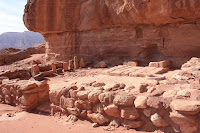 |
| Welcome to Akko! |
 |
| Walking through the Templar Tunnel |
A couple days later I went with some friends to Bethlehem. We took a sherut to Jerusalem, and then a bus to the Bethlehem checkpoint. On the other side of the checkpoint we were persuaded to hire a cab driver to drive us around Bethlehem and surrounding sites. We first went to the Orthodox church of Shepherds' Field. There is a small church there no longer in use, as well as a cave behind it and an archaeological site of a Byzantine Church. Then we left Bethlehem and visited Mar Saba, a Greek Orthodox Monastery in the Kidron Valley dating back 1600 years. This was probably my favorite part of the trip. The monastery, today housing only about 20-25 monks, is built into the cliffs of the valley between the highlands and the desert. The scenery is gorgeous. There are rock-cut dwellings in the cliff-face opposite the monastery, and a path leading to them. The path is steep, but I had fun climbing it. We did not enter the monastery, but I still had a great time.
 |
| Mar Saba |
After leaving Mar Saba we decided to go to Jericho. The drive was long, but the views out over the desert and the Dead Sea were great. When we arrived we visited a church dedicated to the story of Zacchaeus looking at Jesus from a sycamore tree. The inside of the small shrine was painted very lavishly. From there we went to the big gift shop next to the ancient tell, and spent too long being herded around looking at different body products from the Dead Sea. After more than an hour we were allowed to leave and actually enter the tell and look at one of the most ancient cities in the world. The ancient site does not have very good preservation, and there is little for tourists to see. After walking around the tell for a bit we drove to a small stop that looks at the Mt. of Temptation. Then we returned to Bethlehem.
 |
| Church of the Nativity |
Back in Bethlehem we went first to the Milk Grotto Sanctuary, and then to the Church of the Nativity. The inside the Nativity Church is undergoing extensive conservation and renovation work. Scaffolding and cover sheets are up everywhere. What was visible was very beautiful to look at. We walked around Manger Square briefly, then were shepherded to a gift shop where we ended our visit to Bethlehem. On the way home we all agreed that if we went back to any Christian sites (especially in the West Bank) we would rent a car and make the tour ourselves.
My last trip occurred a couple days ago, in Caesarea. During my time studying and working on conservation here two years ago, if Akko was my home then Caesarea was my work site. We spent probably a total of 10 days working at different locations around Caesarea, and it was good to go back and see what had become of our work. One of the biggest changes to the site is that Herod's temple platform in the ancient harbor is undergoing a complete renovation project. Parts of it have been dismantled, and the area is fenced off. Most of the rest of the site hadn't changed much. The ancient city is still always full of tour groups. This time there were groups from the US and local school children there. We walked around the market, the public bathhouse, ancient harbor, and hippodrome. We saw the sunken southern palace, and rested in the theater. We ate ice cream at the entrance, and then walked to the large central hippodrome, that isn't part of the national park. This hippodrome is four times the size of the one on the coast in the park, is not excavated, and has a large obelisk at the center. We rested there, took some pictures, and then headed home to Tel Aviv.
Attached here is the link to all of my photos, for those that don't look at or don't have Facebook. It includes all the photos I've taken while I've been here in Israel, including some of the less spectacular ones that I choose to omit from publishing on Facebook. The link will work no matter how many photos I add, so saving this link will always show you the most up to date files.
https://www.dropbox.com/sh/rzg8dgcag9yjjx7/AADeP0ft-J6r_xxApFqm7p1xa?dl=0





